I am using training an image classification model using the pre-trained mobile network. During training, I am seeing very high values (more than 70%) for Accuracy, Precision, Recall, and F1-score on both the training dataset and validation dataset.


 For me, this is an indication that my model is learning fine.
For me, this is an indication that my model is learning fine.
But when I checked these metrics on an Unbatched training and Unbatched Validation these metrics are very low. These are not even 1%.
Unbatched dataset means I am not taking calculating these metrics over batches and not taking the average of metrics to calculate the final metrics which is what Tensorflow/Keras does during model training. I am calculating these metrics on a full dataset in a single run
I am unable to find out what is causing this Behaviour. Please help me understand what is causing this difference and how to ensure that results are consistent on both, i.e. a minor difference is acceptable.
Code that I used for evaluating metrics My old code
def test_model(model, data, CLASSES, label_one_hot=True, average="micro",
threshold_analysis=False, thres_analysis_start_point=0.0,
thres_analysis_end_point=0.95, thres_step=0.05, classwise_analysis=False,
produce_confusion_matrix=False):
images_ds = data.map(lambda image, label: image)
labels_ds = data.map(lambda image, label: label).unbatch()
NUM_VALIDATION_IMAGES = count_data_items(tf_records_filenames=data)
cm_correct_labels = next(iter(labels_ds.batch(NUM_VALIDATION_IMAGES))).numpy() # get everything as one batch
if label_one_hot is True:
cm_correct_labels = np.argmax(cm_correct_labels, axis=-1)
cm_probabilities = model.predict(images_ds)
cm_predictions = np.argmax(cm_probabilities, axis=-1)
warnings.filterwarnings('ignore')
overall_score = f1_score(cm_correct_labels, cm_predictions, labels=range(len(CLASSES)), average=average)
overall_precision = precision_score(cm_correct_labels, cm_predictions, labels=range(len(CLASSES)), average=average)
overall_recall = recall_score(cm_correct_labels, cm_predictions, labels=range(len(CLASSES)), average=average)
# cmat = (cmat.T / cmat.sum(axis=1)).T # normalized
# print('f1 score: {:.3f}, precision: {:.3f}, recall: {:.3f}'.format(score, precision, recall))
overall_test_results = {'overall_f1_score': overall_score, 'overall_precision':overall_precision, 'overall_recall':overall_recall}
if classwise_analysis is True:
label_index_dict = get_index_label_from_tf_record(dataset=data)
label_index_dict = {k:v for k, v in sorted(list(label_index_dict.items()))}
label_index_df = pd.DataFrame(label_index_dict, index=[0]).T.reset_index().rename(columns={'index':'class_ind', 0:'class_names'})
# Class wise precision, recall and f1_score
classwise_score = f1_score(cm_correct_labels, cm_predictions, labels=range(len(CLASSES)), average=None)
classwise_precision = precision_score(cm_correct_labels, cm_predictions, labels=range(len(CLASSES)), average=None)
classwise_recall = recall_score(cm_correct_labels, cm_predictions, labels=range(len(CLASSES)), average=None)
ind_class_count_df = class_ind_counter_from_tfrecord(data)
ind_class_count_df = ind_class_count_df.merge(label_index_df, how='left', left_on='class_names', right_on='class_names')
classwise_test_results = {'classwise_f1_score':classwise_score, 'classwise_precision':classwise_precision,
'classwise_recall':classwise_recall, 'class_names':CLASSES}
classwise_test_results_df = pd.DataFrame(classwise_test_results)
if produce_confusion_matrix is True:
cmat = confusion_matrix(cm_correct_labels, cm_predictions, labels=range(len(CLASSES)))
return overall_test_results, classwise_test_results, cmat
return overall_test_results, classwise_test_results
if produce_confusion_matrix is True:
cmat = confusion_matrix(cm_correct_labels, cm_predictions, labels=range(len(CLASSES)))
return overall_test_results, cmat
warnings.filterwarnings('always')
return overall_test_results
Just to ensure that my model testing function is correct I write a newer version of code in TensorFlow.
def eval_model(y_true, y_pred):
eval_results = {}
unbatch_accuracy = tf.keras.metrics.CategoricalAccuracy(name='unbatch_accuracy')
unbatch_recall = tf.keras.metrics.Recall(name='unbatch_recall')
unbatch_precision = tf.keras.metrics.Precision(name='unbatch_precision')
unbatch_f1_micro = tfa.metrics.F1Score(name='unbatch_f1_micro', num_classes=n_labels, average='micro')
unbatch_f1_macro = tfa.metrics.F1Score(name='unbatch_f1_macro', num_classes=n_labels, average='macro')
unbatch_accuracy.update_state(y_true, y_pred)
unbatch_recall.update_state(y_true, y_pred)
unbatch_precision.update_state(y_true, y_pred)
unbatch_f1_micro.update_state(y_true, y_pred)
unbatch_f1_macro.update_state(y_true, y_pred)
eval_results['unbatch_accuracy'] = unbatch_accuracy.result().numpy()
eval_results['unbatch_recall'] = unbatch_recall.result().numpy()
eval_results['unbatch_precision'] = unbatch_precision.result().numpy()
eval_results['unbatch_f1_micro'] = unbatch_f1_micro.result().numpy()
eval_results['unbatch_f1_macro'] = unbatch_f1_macro.result().numpy()
unbatch_accuracy.reset_states()
unbatch_recall.reset_states()
unbatch_precision.reset_states()
unbatch_f1_micro.reset_states()
unbatch_f1_macro.reset_states()
return eval_results
The results are nearly the same by using both of the functions.
Please suggest what is going on here.

